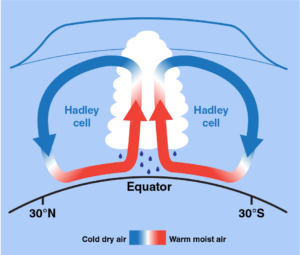On the morning of August 3, 1492, Christopher Columbus set sail on his first voyage to the Americas. He sailed south along the west coast of Africa, searching for the easterly “trade winds,” discovered earlier by the Portuguese, that would propel his fleet westward toward what he thought was India.

The trade winds are a component of a global-scale tropical circulation feature known as the Hadley cell. This cell is driven by the fact that the equator is heated more intensely than latitudes to its north and south, resulting in the production of collections of thunderstorms girdling the globe roughly along the equator.
The rising air that fuels these thunderstorms spreads out at the tropopause (about nine miles high) and heads both north and south. Cooling at the cloud tops of this poleward-directed air forces it to sink at about 25 degrees latitude on either side of the equator. The sinking air that reaches the surface in the Northern Hemisphere heads southward toward the equator in a huge vertical circulation cell. The rotation of the Earth, and the resulting Coriolis force, turns this southward moving air to its right, creating the near surface trade winds.
Though known by mariners for centuries, it was not until 1735 that George Hadley proposed this explanation for the trade winds. It was not until the 1950s, amazingly, that observational evidence provided by balloon soundings of the atmosphere finally confirmed the veracity of Hadley’s conjecture.
Steve Ackerman and Jonathan Martin, professors in the UW-Madison department of atmospheric and oceanic sciences, are guests on WHA radio (970 AM) at 11:45 a.m. the last Monday of each month. Send them your questions at stevea@ssec.wisc.edu or jemarti1@wisc.edu.

